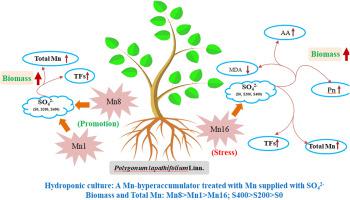Ecotoxicology and Environmental Safety ( IF 6.8 ) Pub Date : 2021-02-13 , DOI: 10.1016/j.ecoenv.2021.112036 Kehui Liu , Chunming Li , Chenglong Dai , Rilan Qin , Xiaolu Liang , Yi Li , Fangming Yu

|
A hydroponic method was performed to explore the effects of sulfate supply on the growth, manganese (Mn) accumulation efficiency and Mn stress alleviation mechanisms of Polygonum lapathifolium Linn. Three Mn concentrations (1, 8 and 16 mmol L−1, representing low (Mn1), medium (Mn8) and high (Mn16) concentrations, respectively) were used. Three sulfate (S) levels (0, 200, and 400 μmol L−1, abbreviated as S0, S200 and S400, respectively) were applied for each Mn concentration. (1) The average biomass (g plant−1) of P. lapathifolium was ordered as Mn8 (6.36) > Mn1 (5.25) > Mn16 (4.16). Under Mn16 treatment, S addition increased (P < 0.05) biomass by 29.96% (S200) and 53.07% (S400) compared to that S0. The changes in the net photosynthetic rate and mean daily increase in biomass were generally consistent with the changes in biomass. (2) Mn accumulation efficiency (g plant−1) was ordered as Mn8 (99.66) > Mn16 (58.33) > Mn1 (27.38); and S addition increased (p < 0.05) plant Mn accumulation and Mn transport, especially under Mn16 treatment. (3) In general, antioxidant enzyme activities (AEAs) and malondialdehyde (MDA) in plant leaves were ordered in Mn16 > Mn8 > Mn1. Sulfate addition decreased (P < 0.05) AEAs and MDA under Mn16 treatment, while the changes were minor under Mn1 and Mn8 treatments. (4) Amino acid concentrations generally increased with increasing Mn concentration and S level. In summary, the medium Mn treatment promoted plant growth and Mn bioaccumulation; sulfate, especially at 400 µmol L−1 S, can effectively promote plant growth and Mn accumulation efficiency. The most suitable bioremediation strategy was Mn16 with 400 µmol L−1 S.
中文翻译:

硫酸盐在促进植物提取的Mn效率和减轻的Mn应力所述的新的作用酸模叶蓼属
进行了水培研究,探讨了硫酸盐供应对何首乌生长,锰(Mn)积累效率和锰胁迫缓解机制的影响。使用了三种Mn浓度(分别为低(Mn1),中(Mn8)和高(Mn16)浓度的1、8和16 mmol L -1)。对每个Mn浓度施加三个硫酸盐(S)水平(分别为0、200和400μmolL -1,分别缩写为S0,S200和S400)。(1)的平均生物量(克植物-1)的P.叶蓼排序是MN8(6.36)>管Mn1(5.25)> MN16(4.16)。在Mn16处理下,S的添加增加(P <0.05)的生物量分别比S0低29.96%(S200)和53.07%(S400)。净光合速率的变化和生物量的日均增加量通常与生物量的变化相一致。(2)Mn累积效率(g plant -1)按Mn8(99.66)> Mn16(58.33)> Mn1(27.38)的顺序排列;硫和硫的添加增加(p <0.05)植物锰的积累和锰的运输,特别是在Mn16处理下。(3)通常,植物叶片中的抗氧化酶活性(AEA)和丙二醛(MDA)顺序为Mn16> Mn8> Mn1。硫酸盐添加减少(P <0.05)Mn16处理下的AEA和MDA,而Mn1和Mn8处理下的变化很小。(4)氨基酸浓度通常随着锰浓度和硫水平的增加而增加。总之,中等锰处理促进了植物的生长和锰的生物积累。硫酸盐,特别是在400 µmol L -1 S下,可以有效促进植物生长和Mn积累效率。最合适的生物修复策略是MN16与400微摩尔大号-1 S.



























 京公网安备 11010802027423号
京公网安备 11010802027423号